|
As General Kershaw's regiment worked their way down the east slope of the "Stony Hill", they were able to put some well-placed fire on the Union guns. To avoid having their guns captured, the Union artillerymen...limbered up and withdrew.
General Birney, the Union Third Corps Commanding General, sent in to the fray to try and reestablish the Union line, met the men of the 17th Maine as they crossed the field and got to the "Wheatfield" road. General Birney, trying to rally the Union soldiers, rode in front of the regiment and ordered a charge as a delaying action. Which they did, checking the advance of Confederate General Anderson's troops.
General Birney, in an attempt to strengthen his emboldened position, went back to "Trostle's Woods" and ordered the 5th Michigan forward, into the "Wheatfield". There, the 17th Maine and the 5th Michigan stood, trying to hold their line until reinforcements could arrive. The roar of battle was deafening and the action became hand to hand, all along the line. Casualties were heavy on both sides, the 17th Maine reporting seven out of ten men in their color guard were either wounded or killed. The 17th Maine would suffer 35 percent casualties, the 5th Michigan over 40 percent casualties.
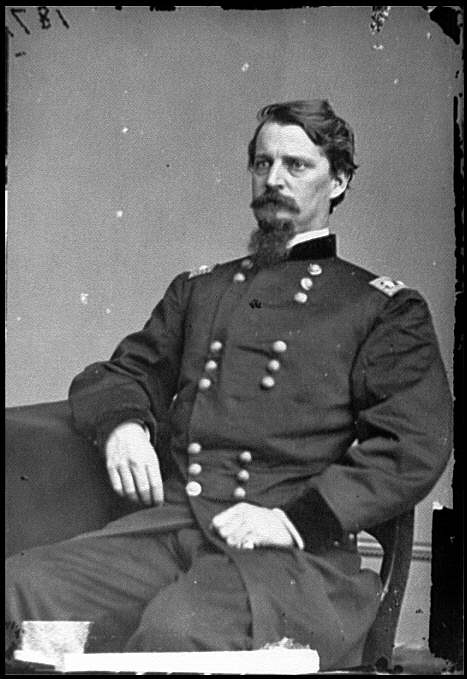 Major General Winfield S. Hancock, USA
Major General Winfield S. Hancock, USA |
A few minutes before, seeing the disaster happening at the "Wheatfield", Major General Winfield Scott Hancock had his men alerted on the southern end of Cemetery Ridge. He knew that reinforcements were needed and sent Colonel Edward Cross, forward saying, "Colonel, this day will bring you a star." To this, General Hancock's brightest and bravest Colonel replied "No general, this is my last battle". Within minutes, Cross would set off at the head of his brigade to meet his fate in the "Wheatfield".
This was as a part of General Caldwell's Division which once before been ordered forward but had returned to Cemetery Ridge when he noted the 5th Corps was already moving up as reinforcements. Now, he was again ordered forward, but now in support of the 5th Corps. His division was made up of four brigades: Cross's Brigade, General Zook's brigade, Colonel Brookes' brigade and Colonel Kelly's Irish brigade.
It was as the Irish Brigade, marched off for what could be their last battle, the famed Father William Corby stood upon a rock and gave absolution to the whole brigade. To be sure, the men of Caldwell's division knew that the battle ahead was not going to be easy. |
|
Hurried, General Caldwell's division was forced to enter the battle piecemeal. As a brigade formed up, they were immediately sent forward. Colonel Cross's brigade was the first to go in, moving swiftly towards "Rose's Woods" and General Anderson's awaiting troops. Part of Cross's brigade, the 5th New Hampshire and part of the 148th Pennsylvania were able to gain cover from "Rose Woods" as they advanced. However, the 61st New York and also the 81st Pennsylvania, had no such cover and had to advance straight across the field under an intense fire.
Colonel Cross, able to halt General Anderson's troops and push his brigade back slightly, before his advance stalled, had his premonition come true as he was shot down. His last known words were, "I did hope I should see peace restored to our distressed country. I do think the boys will miss me. Say goodbye to all." Succeeding to command was Colonel McKeen. |
|
At the time Colonel Cross was mortally wounded, General Zook was preparing his advance from the "Wheatfield" road towards the "Stony Hill". However, he soon ran into masses of Barnes's troops reforming in "Trostle's Woods". General Zook's brigade made up of the 66th New York, 52nd New York, 140th Pennsylvania, moved forward as the 57th New York was held in reserve.
Colonel Richard P. Roberts,commander of the 140th Pennsylvania...in an attempt to rally his men and prepare them for the fight to come shouted, "Men of the 140th, recollect that you are now defending your own soil, and are fighting to drive the invader from your own homes and firesides. I shall expect you to conduct yourselves as if in the presence of your wives, you sisters, and your sweethearts, and not disgrace the flag you bear or the name of Pennsylvania!"
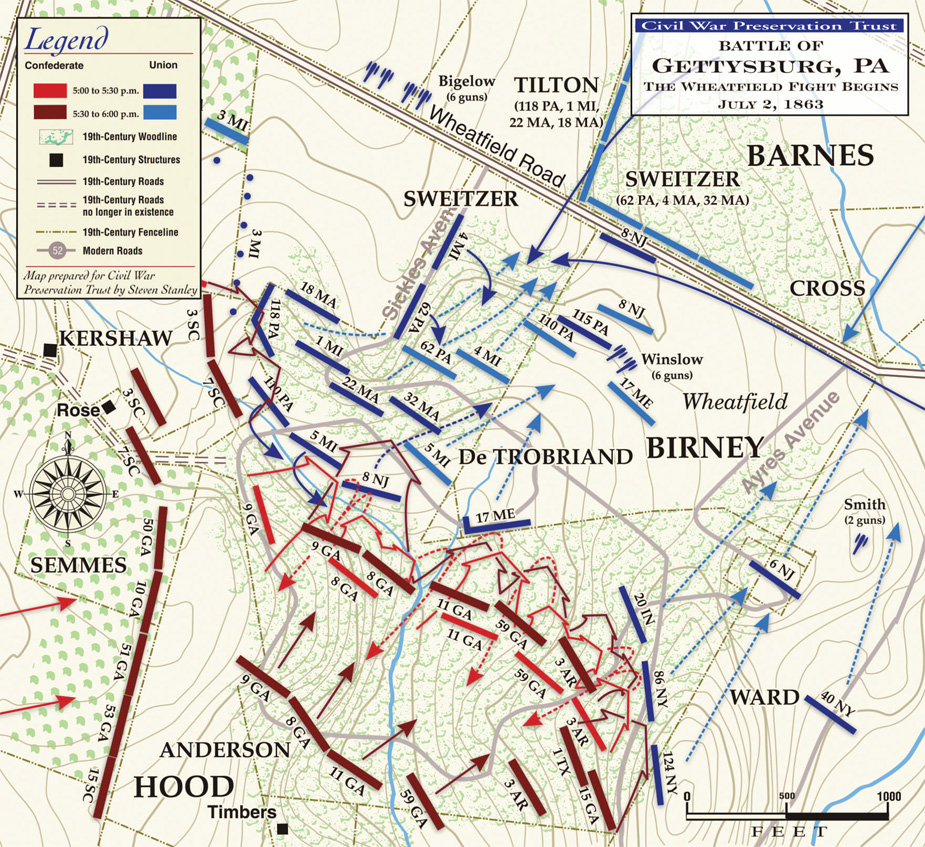 Battle Map of the Wheatfield Battle Map of the Wheatfield
|
It was not long after they started their advance, General Zook' brigade were engaged in a desperate battle with General Kershaw's men on the Stony Hill. They quickly scrambled up the wooded heights. While leading his brigade up the slope, General Zook was shot off his horse and fell mortally wounded. As he turned to his aide, Lieutenant Josiah Favill, he said, "It's all up with me, Favill." Union General Caldwell had lost his second brigadier with in a matter of minutes.
|
| 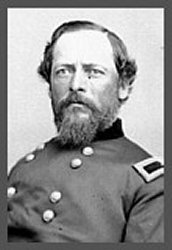 General Samuel Zook, USA General Samuel Zook, USA
|
|
|
Kelly's men, unlucky throughout the war thus far, stepped into the Wheatfield, no cover available to them, counting on their extreme courage to see them through this fight. Aligned to their right was the 116th Pennsylvania, followed by the 28th Massachusetts, 63rd New York, 69th New York, and the 88th New York was on their left flank.
Kershaw's two regiments were now being hit from both sides at once. Kelly's Irish brigade hit them on the right and Zook's brigade hit them on the left. General Kershaw would later proclaim, "I have never been in a hotter place." Confederate reinforcements from Semmes brigade came up on General Kershaw's right, to help out against the Irish Then General Kershaw bent the line of the of the 7th South Carolina back, but soon realized the pressure more than his men could withstand. Slowly but surely, the Union soldiers were pushing General Kershaw's South Carolinians back.
Colonel John R. Brooke's brigade, held in reserve along the Wheatfield road, was sent in to the fray as Colonel Cross' men were running low on ammunition and their advance had stalled. Generals Semmes and Anderson were beginning to flank the Irish brigade. Help was badly needed and General Caldwell ordered Brook's brigade forward.
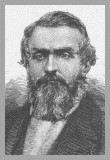 General Paul J. Semmes, CSA
General Paul J. Semmes, CSA |
Brooke's brigade soon came to the relief of Cross' brigade, and with parts of Cross's brigade joining his fresh advancing troops, quickly reached Rose Wood's. His troops hit General Anderson's line and drove him back across the western branch of Plum Run and out of the woods. Included in Brooke's brigade were the 145th Pennsylvania, 27th Connecticut, 53rd Pennsylvania, 64th New York, and the 2nd Delaware. As General Anderson's line began to retreat Brooke's advancing Federals were able to hit General Paul Semmes brigade, which had fallen in on the right of Kershaw. It was not long after that they too began to retreat, as the Union troops swiftly climbed the Stony Hill. Seeing that both flanks were being turned, General Kershaw was forced to fall back. General Caldwell's Union division had triumphed, and had driven the gallant Confederates back.
Even as they were retreating, General Anderson's brigade was giving trouble on to General Caldwell unprotected left flank. Seeking assistance from the General Barnes of the 5th Corps, he was given help from Sweitzer's brigade. Sweitzer's men then advanced from Trostles Woods, into the field to support Brooke's left flank. |
|
On the north slope of Little Round Top, the brigades of Colonels Sidney Burbank's and Hannibal Day's, began to advance across the valley towards the now heavy fighting going on in the Wheatfield. They halted at the stone wall on the eastern edge, but were unable to enter the fight as Brooke's brigade, and then Sweitzer's brigade, were moving perpendicularly across their front.
General Caldwells men were now nearly in charge of the field. However, as General Kershaw was not quite licked yet and his spirits were high, as he remarked in recalling the sight of advancing Coonfederate soldiers coming to his aid as he emerged from Rose Woods: "I saw Wofford coming in splendid style." |
|
Here, I have provided an excerpt from General Joseph Kershaw's official report of the battle to his commanding general, General Lafayette McLaws describing the advance of General Wofford's and his Georgian Brigades:
Report of Brig. Gen. J. B. Kershaw, C. S. Army, commanding brigade, McLaws' division
JUNE 3-AUGUST 1, 1863.--The Gettysburg Campaign
HEADQUARTERS KERSHAW'S BRIGADE,
Near Chattanooga, October 1, 1863.
Maj. J. M. GOGGIN,
Assistant Adjutant-General
"On emerging from the wood, I saw Wofford coming in in splendid style.
My left wing had held the enemy in check along their front, and lost no ground. The enemy gave way at Wofford's advance, and, with him, the whole of my left wing advanced to the charge, sweeping the enemy before them, without a moment's stand, across the stone wall, beyond the wheat-field, up to the foot of the mountain. At the same time, my Fifteenth Regiment, and part of Semmes' brigade, pressed forward on the right to the same point. Going back to the stone wall near my rear, I found Colonel Aiken in position, and at the stone building found the Third South Carolina and the regiment of Semmes' brigade. I moved them up to the stone wall, and, finding that Wofford's men were coming out, I retained them at that point to check any attempt of the enemy to advance." |
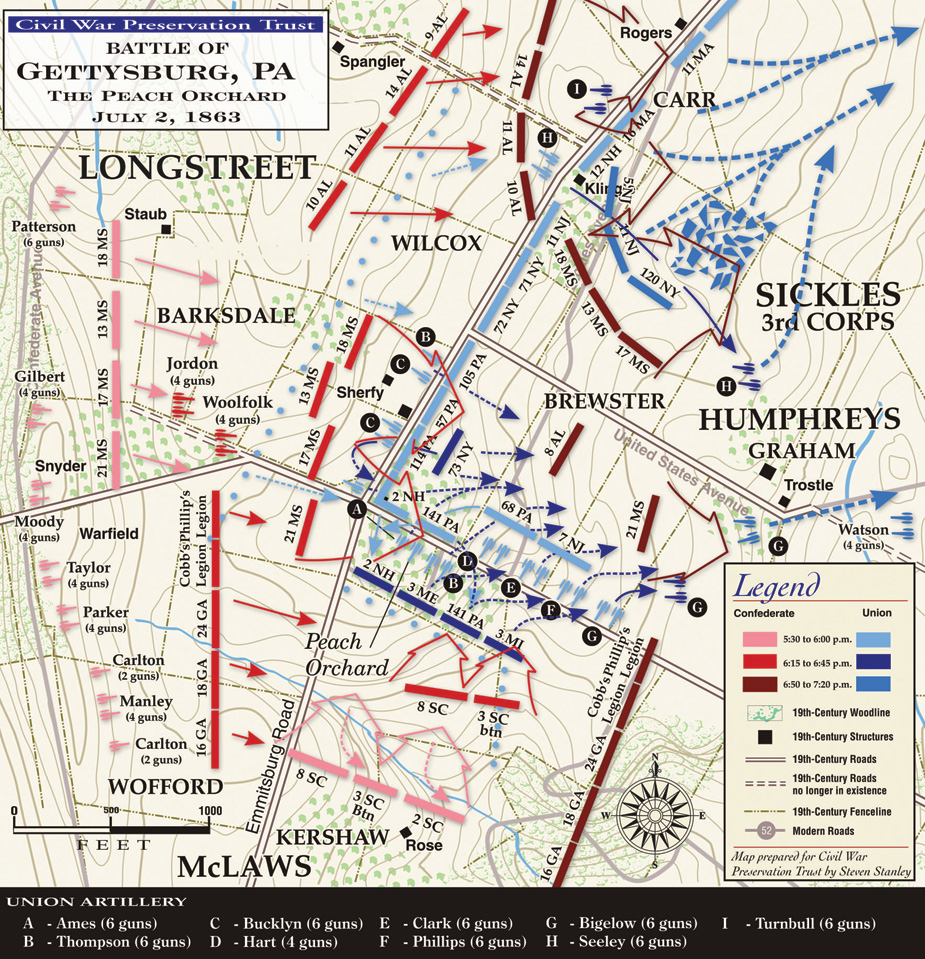 Battle Map of the Peach Orchard
Battle Map of the Peach Orchard |
|
General William Barksdale's Mississippi troops had been delayed by the batteries in front of his jump off point, but had finally began their advance. He pushed his men quickly towards the Peach Orchard, crashing into the Union positions and driving everything in front of them. He then turned them to the northeast, began to sweeping away the Union brigades of Graham and Humphreys's division who were posted along the Emmitsburg Road. Supporting General Barksdale's advance was General William Tatum Wofford's brigade of Georgians. Accompanying the Georgians was none other than General Longstreet himself, who it seems diverted General Wofford's brigade to support General Anderson's men near the Stony Hill, instead of having him follow Barksdale.
As General Wofford's Georgians were always ready for any test, the 16th, 18th, and 24th regiments, along with Philip's and Cobb's legions advanced swiftly through the now cleared Peach Orchard straight for Union General Zook's open flank.
When Wofford hit the unprotected Union flank, the weary and badly worn federal troops began to break. The deciding moment in the contest for the Wheatfield fight had finally come. Unable to withstand the onslaught of the fresh Georgian troops, the northerners troops hurriedly withdrew in disorder. The troops of Kelly's famed Irish brigade confused and their fear of being surrounded was such that some units were ordered to break ranks and it was every man for themselves.
|
| 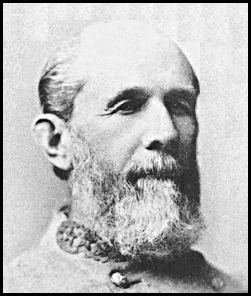 General William T. Wofford, CSA General William T. Wofford, CSA
|
|
As General Wofford's brigade advanced, it rallied the the whole Confederate line as General Kershaw's left wing, the 8th, 3rd battalion, and 2nd South Carolina joined in, as well as much of Semmes and Anderson's brigades. It seemd that all of Confederate effort was squarely concentrated against the Union forces in the Wheatfield. |
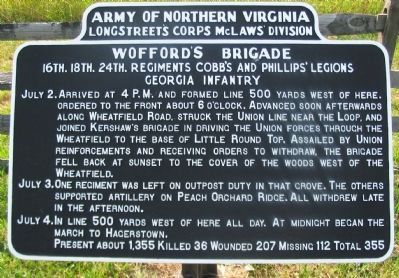 Wofford's Brigade Marker
Wofford's Brigade Marker |
|
A Union officer would later comment of General Barksdale's 1,600 troops and General Wofford's 1,300 charging Georgian's advance on the Peach Orchard position as "the grandest charge that was ever made by mortal man."
Union Colonel Tilton, whose troops were stationed in Trostle's woods facing west, again left the field early. Faced with the advancing Georgians, they failed to even try to demonstrate or feint action to check the advance. They simply faded from the field.
Now unsupported, Brooke's troops were also forced to fall back. Pressure on his left flank as General Anderson troops returned in their advance accompanied by Semmes Confederate troops against his front and flank, Brookes lost all hope of holding on to his hard fought ground. It was not long before his troops were also swept up in the route.
However, not all of the Union commanders were ordering their men from the field. Union commander Jacob Sweitzer reacted swiftly to try and check the Confederate advance. He the troops of the 4th Michigan and the 62nd Pennsylvania to confront the coming storm of Wofford, Kershaw, and Semmes, and left the 32nd Massachusetts to fend off Anderson's men. |
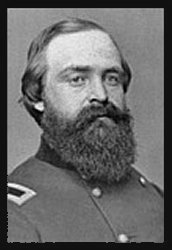 General John C. Caldwell, USA
General John C. Caldwell, USA |
General Caldwell was back near the lines formed by Burbank and Day's men, still at the eastern stone wall. As Kelly and Zook's men began to run out of the woods across the field, an aide remarked to the General, "General, you had better watch out, the line in front is giving way." General Caldwell simply replied that the troops were only being relieved by fresh troops. Watching the paniced Union soldiers and still quite worried, frantically spoke up again to the General, saying "I don't care what any one says, those troops in the front are running away." This caught the attention of General Caldwell and General Ayres, who he had been conferring with, and they both moved off to attend to their men.
With most of Sweitzer's brigade now shifted to meet Semmes, Wofford and Kershaw head on, General Ayres now directed Colonel Burbank to move his regulars from behind the stonewall and into the Wheatfield. He was to wheel to the left and hit General Anderson's troops. Colonel Burbank moved his men as he was ordered, sending in the 17th US, 11th US, 10th US, 7th US, and the 2nd US. However, with Sweitzer's men breaking, he had not the support to maintain pressure and effect any real damage on the hard fighting Confederates. |
|
Soon, Colonel Burbank was also forced to withdraw from the Wheatfield. Colonel Hannibal Day's brigade of regulars, was now all that stood in the way of the advancing Confederates. However, unlike Colonel Burbanks bold advance, Colonel Day ordered his troops to fall back, fighting across the Plum Run Valley. The Confederates now controlled and swept through the Wheatfield.
It seemd to the Confederates in the Wheatfield that the whole war was to be decided here, in this part of the battlefield. Confederate artillerist, Colonel E.P. Alexander later stated that while viewing the retreating Union soldiers as he hurried his battalions through the Peach Orchard, "When I saw their line broken and in retreat, I thought the battle was ours…I rode along my guns, urging the men to limber to the front as rapidly as possible, telling them we would 'finish the whole war this afternoon.'"
While it seemed to some that total victory was theirs, General Longstreet was not as enthusiastic and sure as most. He could see troops from the Union 5th Corps were still arriving on Little Round Top, and still thousands of troops from the Union 6th corps were still arriving every minute. Knowing the Union soldiers would be ordered to counterattack, the "Old Warhorse", General James Longstreet, ordered his tired but faithful troops to fall back into the Wheatfield.
General Wofford, among others, was both surprised and angered by General Longstreet's decision. What he and the rest did not realize. the Union forces disposition was improving by the minute. As General Longstreet's men pulled back to the Wheatfield, Colonel William McCandless's brigade of Pennsylvania reserves, were advancing and would soon check Generals Anderson, Semmes, and Kershaw. Union General Frank Wheaton was also advancing his troops and was about to check General Wofford's Georgians. Behind these blue clad soldiers, were still more and more reinforcements...coming up quickly to plug the gaps made by the fleeing Union soldiers who had been run from the Wheatfield and the Peach orchard.
General Meade, commanding Genreral of the Army of the Potomac, had brilliantly considered the situation and had made just the right moves at just the right time. He was pouring reinforcements over the northern slope of Little Round Top, saving the day and probably the entir battle, at that moment.
The fight in the Wheatfield was finally over. The Confederates had won the field, but the Union stioll held the high and critical areas. The 2nd Day of gettysburg had come to an end. General Wofford's brigade of Georgians, like all those who had battled here in the Peach Orchard, the Wheatfield and the surrounding Rose' and Trostle's Woods, could now get some much need rest. Feeling as though they had given it their best and not knowing what the third day of the battle was about to bring...they laid on their weapons that nigh, assured of their places in History. There in that hell, known as the Wheatfield.
General Kershaw's losses numbered 630 killed, wounded and missing.
Genral Semmes' losses numbered 430 killed, wounded and missing.
Genral Wofford's Georgians lost 334 killed, wounded, and missing.
Union losses at the Wheatfiled numbered 3,215 killed, wounded or missing. |
| |